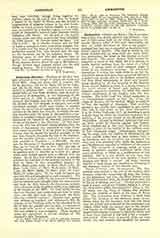

Ammonian Sections. —Divisions of the four Gospels indicated in the margin of nearly all Greek and Latin MSS. They are about 1165 in number; 355 for St. Matthew, 235 for St. Mark, 343 for St. Luke, and 232 for St. John; the numbers, however, vary slightly in different MSS. Until recently it was commonly believed that these divisions were devised by Ammonius of Alexandria, at the beginning of the third century (c. 220), in connection with a Harmony of the Gospels, now lost, which he composed. He divided the four Gospels, it was said, into small numbered sections, which were similar in content where the narratives are parallel, and then wrote the sections of the three last Gospels, or simply the section numbers with the name of the respective evangelist, in parallel columns opposite the corresponding sections of the Gospel of St. Matthew, which he had chosen as the basis of his Harmony. Of late, however, the view has obtained among scholars that the work of Ammonius was restricted to what Eusebius states concerning it in his letter to Carpianus, namely, that he placed the parallel passages of the last three Gospels alongside the text of St. Matthew, and the sections hitherto credited to Ammonius are now ascribed to Eusebius (A.D. 265-340). At any rate the Harmony of Ammonius suggested to Eusebius, as he himself tells us (loc. cit.), the idea of drawing up ten tables (kanones) in which the sections in question were sa classified as to show at a glance where each Gospel agreed with or differed from the others. In the first nine tables he placed in parallel columns the numbers of the sections common to the four, or three, or two, evangelists; namely: (I) Matt., Mark, Luke, John; (2) Matt., Mark, Luke; (3) Matt., Luke, John; (4) Matt., Mark, John; (5) Matt., Luke; (6) Matt., Mark; (7) Matt., John; (8) Luke, Mark; (9) Luke, John. In the tenth he noted successively the sections special to each evangelist. The usefulness of these tables for the purpose of reference and comparison soon brought them into common use, and from the fifth century the Ammonian sections, with references to the Eusebian tables, were indicated in the margin of the MSS. (It need hardly be said that our chapters and verses were not then in existence; the first date from the thirteenth, the latter from the sixteenth century.) Opposite each section was written its number, and underneath this the number of the Eusebian table to be consulted in order to find the parallel texts or text; a reference to the tenth table would of course show that this section was proper to that evangelist. These marginal notes are reproduced in several editions of Tischendorf’s New Testament.
F. BECHTEL

